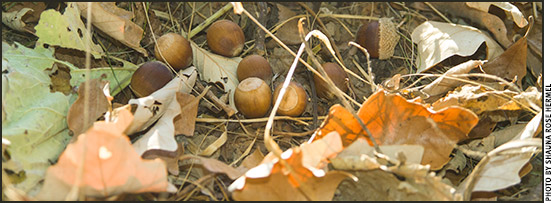
Acorn Poisoning in Cattle
As treatment options are limited, preventing acorn poisoning is a producer’s best option.
When forage is scarce, cattle will often search for alternative food sources. In Arkansas, where cattle are frequently grazed on pastures that may contain oak timber, there is the possibility for cattle to consume acorns. When cattle head to available timber ground and wooded lots around the farm in search of grazing or browsing during the fall of the year, hungry cattle will frequently eat acorns dropped by oak trees. If these acorns are overconsumed, they have the potential to cause fatal poisoning.
Clinical signs
Tannins are the toxic agents that are found in acorns. Consumption of tannins can lead to gastrointestinal problems, severe kidney damage and death. Some cattle may consume acorns and experience no ill effects, while others suffer severe disease.
Early signs associated with acorn poisoning are related to gastrointestinal dysfunction. These include abdominal pain, poor appetite, diarrhea (often black or bloody in color), and occasional constipation. As the disease progresses, signs of kidney failure will present themselves.
You can look for affected cattle to exhibit dehydration (a dry, crusty muzzle and rough hair coat); increased thirst; general weakness; weight loss; frequent urination; and a rapid, weak pulse. Edema (swelling due to fluid that has settled out into tissue) may be noted in the lower parts of the body such as the chest, legs and ventral abdomen. Some body cavities may also become filled with fluid.
Treatment
Since there is no specific antidote for acorn poisoning, treatment for acorn poisoning is limited. However, for cattle exhibiting signs of constipation, 1 gallon of mineral oil or a saline cathartic can be administered orally as a mild laxative. Activated charcoal can also be given to aid in absorption of the toxic agent. With these limited treatment options, emphasis should be placed on prevention.
Prevention
The best practice for prevention of acorn poisoning is to keep cattle from coming in contact with the culprit. Fencing off an area where oaks are prevalent is the best way to prevent exposure. If that is not possible, supplementing the cattle with feed that contains 10% hydrated lime (calcium hydroxide) will lessen the hazard of acorn poisoning. Hydrated lime should be placed in a mixed ration because it is generally unpalatable to cattle. It can also be placed into a pelleted ration to get the desired consumption rate.
If a producer is concerned about acorn poisoning in his herd, the following ration can be fed to cattle at 3-4 pounds (lb.) per head per day for adult cattle (1-2 lb. per head per day to calves):
- 44% cottonseed or soybean meal;
- 40% dehydrated alfalfa meal, corn or cottonseed hulls;
- 6% vegetable oil or molasses; and
- 10% hydrated lime.
The goal is to get cows to consume around 0.4 lb. of hydrated lime per day. The use of molasses or vegetable oil is important to keep the hydrated lime from settling out of the ration and also to increase palatability. Cattle that are not commonly fed grain should be slowly acclimated to consuming the full ration. In addition to the above detailed supplementation, providing cattle with additional food sources will cause them to be less likely to search for acorns while grazing short pasture.
There appear to be fewer problems with acorn poisoning after a few hard freezes. Since freezing does not actually decrease the level of tannins found in acorns, the fewer problems are most likely due to the reduced palatability of acorns after weathering has occurred. For more information about this disease and other diseases affecting cattle, contact your local county Extension office.

Editor’s Note: Jeremy Powell is an extension veterinarian with the University of Arkansas. Reprinted with permission from the Livestock Health Series.





